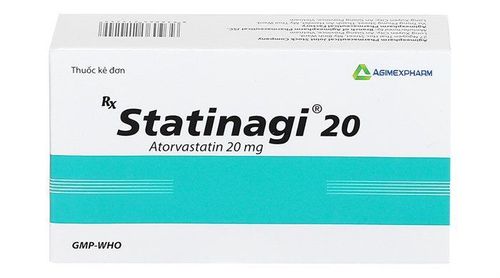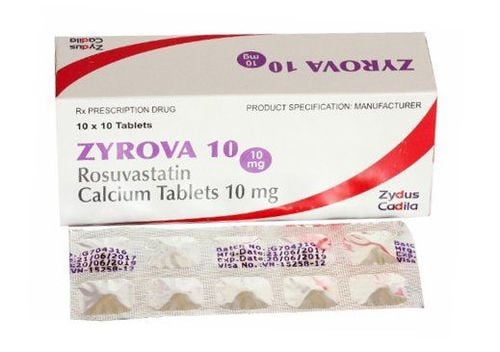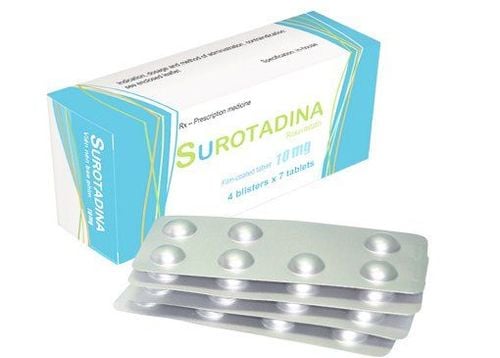This is an automatically translated article.
Vytorin is a drug to treat dyslipidemia. The main ingredients of Vytorin include: Ezetimibe and simvastatin, made in tablet form, packed in a box of 3 blisters x 10 tablets. To learn detailed information about the drug Vytorin, follow the article below.
1. What is Vytorin?
The Ezetimibe component in Vytorin is localized to the small intestine wall and inhibits cholesterol absorption, leading to a decrease in cholesterol transport from the intestine to the liver. Ezetimibe inhibits cholesterol absorption without affecting the absorption of triglycerides, fatty acids, bile acids, progesterone, ethinyl estradiol, or fat-soluble vitamins A and D.Simvastatin reduces both normal and elevated LDL-C levels. During treatment with simvastatin, Apolipoprotein B was also significantly reduced. Simvastatin moderately increases HDL-C and decreases plasma triglycerides. The result was a reduction in the total cholesterol/HDL-C ratio and the LDL-C/HDL-C ratio.
2. What are the uses of Vytorin?
Treatment of primary hypercholesterolemia: Vytorin reduces total cholesterol, low-density lipoprotein cholesterol (LDL-C), apolipoprotein B (Apo B), triglycerides (TG) and non-HDL-cholesterol (non-HDL-) C); increased high-density lipoprotein cholesterol (HDL-C) in people with primary hypercholesterolemia or mixed hyperlipidemia. Treatment of homozygous familial hypercholesterolemia (HoFH): Vytorin reduces total cholesterol and LDL-C in adults with HoFH. Vytorin should be used as an adjunct to other lipid-lowering treatments (such as LDL apheresis) in these individuals. Vytorin should not be used in the following cases:
Allergy to any of the ingredients in the drug. Active liver disease, liver failure Persistent elevation of plasma transaminases, of unknown cause. During pregnancy and lactation. Co-administration of Vytorin with strong inhibitors of CYP3A4 (such as itraconazole, ketoconazole, HIV protease inhibitors, posaconazole, boceprevir, telaprevir, erythromycin, telithromycin, clarithromycin, nefazodone, and drugs containing cobicistat). Used in combination with gemfibrozil, cyclosporin, danazol. Myopathy secondary to drug use.
3. Dosage of Vytorin
Vytorin is taken orally, taken with filtered water. Vytorin should be taken only once in the evening.
Dose for primary hypercholesterolemia
Dietary cholesterol is required prior to initiating and during treatment with Vytorin. Start treatment with the lowest effective dose Vytorin dose: from 10/10 mg/day to 10/80 mg/day. Adjust Vytorin dose at least every 4 weeks, up to a maximum of 10/80 mg/day. Vytorin 10/80mg dose is only used for patients at high risk of cardiovascular complications who have not achieved treatment goals with lower doses. Dosage for treatment of homozygous familial hypercholesterolemia (HoFH)
Vytorin dose: 10/40 mg/day or 10/80 mg/day. Use 10/80 mg only when the expected benefit outweighs the risk. In patients being treated with lomitapide, the dose of Vytorin should not exceed 10/40 mg/day. Renal Impairment
In patients with moderate renal impairment, no dose adjustment is required in Vytorin. In patients with severe renal impairment (creatinine clearance < 30 mL/min), close monitoring is recommended if doses higher than 10/10 mg/day are used. Elderly: No dose adjustment is required.
Hepatic impairment: In patients with mild hepatic impairment (Child-Pugh 5 or 6), no dose adjustment is required. Vytorin should not be used in patients with moderate (Child-Pugh 7 to 9) or severe (Child-Pugh >9) hepatic impairment.
Combination of Vytorin with other drugs
Vytorin should be taken at least 2 hours before or at least 4 hours after taking a bile acid absorber. In patients receiving verapamil or diltiazem, the dose of Vytorin should not exceed 10/10 mg/day. In patients receiving amiodarone or amlodipine, the dose of Vytorin should not exceed 10/20 mg/day. Note: The specific dose of Vytorin depends on the condition and severity of the disease.
In the event of an overdose with unusual symptoms, call 911 immediately or go to the nearest medical facility. When you miss a dose of Vytorin, take it as soon as possible. If it is almost time for your next dose, skip the missed dose of Vytorin and take your next dose as usual. Do not double the prescribed dose of vytorin.
4. Side effects of Vytorin
Common: Increased ALT, AST, increased blood CK, dizziness, headache, muscle pain... Uncommon: Hyperbilirubinemia, hyperuricemia, increased prothrombin time/international normalized ratio, increased gamma-glutamyltransferase, protein in the urine, weight loss, abdominal discomfort, bloating, indigestion, nausea, vomiting...
5. Notes when taking Vytorin
Myopathy/rhabdomyolysis
Simvastatin can cause myopathy manifesting in: myalgia, muscle tension, muscle weakness, rhabdomyolysis. The risk of myopathy increases with increasing plasma concentrations of HMG-CoA reductase inhibitors. In patients receiving Vytorin 10/80 mg who require a drug with a potential for interaction, a lower dose of Vytorin or an alternative to a statin-ezetimibe is recommended. Before taking Vytorin, it is necessary to have a CK test in the following cases: Impaired renal function, hypothyroidism, personal or family history of hereditary myopathy, history of myopathy caused by previous statin or fibrate use , history of liver disease, heavy alcohol consumption, elderly patient, female patient. If CK results are significantly elevated (>5 ULN) treatment with vytorin should not be initiated. Vytorin should be discontinued immediately if myopathy is diagnosed or suspected. Most of the time when patients stop taking Vytorin, their symptoms and CK levels return to normal. CK should be checked periodically. Liver enzymes:
Liver function should be checked before starting Vytorin. Before increasing the dose of Vytorin to 10/80 mg, 3 months after the increase, and every 6 months thereafter during the first year of treatment, the test should be repeated. Use caution in patients with elevated serum transaminase levels. If a progressive increase in transaminase levels is observed, especially when increased to 3 times the upper limit of normal and persists, the drug should be discontinued. Vytorin immediately. Vytorin should be used with caution in people who drink heavily and have a history of liver disease.
6. Vytorin drug interactions
Use of Vytorin with fenofibrate or gemfibrozil increases ezetimibe levels. When fusidic acid is co-administered with Vytorin, the risk of myopathy may be increased. When amiodarone is used with Vytorin, the risk of myopathy is increased. Concomitant use with cholestyramine results in a less effective LDL-C reduction. When combined with verapamil, diltiazem, amlodipine, the risk of myopathy/rhabdomyolysis is increased. When combined with lomitapide, the risk of myopathy/rhabdomyolysis is increased. Co-administration of moderate CYP3A4 inhibitors with Vytorin, may increase the risk of myopathy. Concomitant administration of OATP1B1 transporter protein inhibitors with Vytorin may increase plasma concentrations of simvastatin acid, increasing the risk of myopathy. Co-administration of niacin with Vytorin may cause a slight increase in mean AUC of niacin, nicotinuric acid, ezetimibe, and simvastatin. Myopathy and rhabdomyolysis have been reported with the combination of colchicine and Vytorin in patients with renal impairment. Avoid drinking too much grapefruit juice (more than 1 liter/day) while taking Vytorin. Vytorin is a drug used in the treatment of dyslipidemia. When taking Vytorin, you need to combine it with a proper diet and exercise
. Contact your doctor if you have any questions about Vytorin.
Please dial HOTLINE for more information or register for an appointment HERE. Download MyVinmec app to make appointments faster and to manage your bookings easily.













